
Ajanta Caves in Central India
Do you have an appetite for history? Are you a complete buff when it comes to spiritual travel? Also, will you like some scenic pleasures at one of the most offbeat destinations in India? If the answer to any of these questions is a yes, then, we believe that you will love some cave jaunts at Ajanta Caves.
Famous around the globe for its impalpable treasures of Buddhism, Ajanta Caves hits another milestone with its nature’s bounty. There is so much to grasp and so much to explore that even keeping track of time becomes an issue here.
Will you like to get your head buried deeper in history? Then, this destination will be more than perfect for you. Planning a holiday to India soon? Then, you should definitely add Ajanta caves to your places to visit in India list. Is it added to it already? Then, there is nothing better than a guide to help you through. We told you, we have your back. Happy reading, you all!
AJANTA CAVES’S JOURNEY THROUGH THE SANDS OF TIME
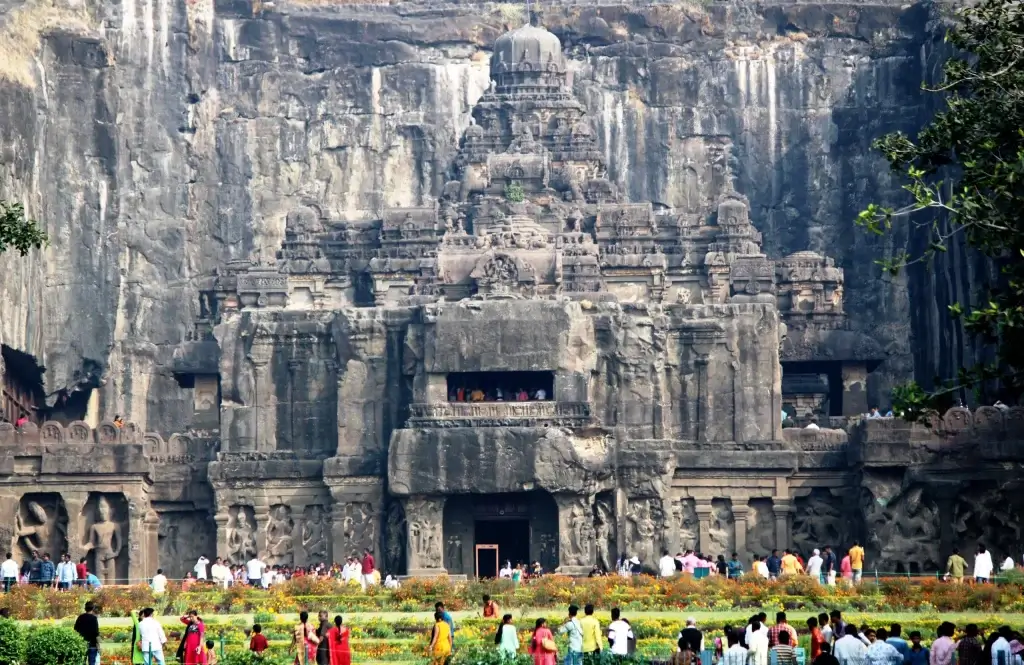
Through the ravages of time, Ajanta Caves have been celebrated as one of the most revered World Heritage Sites. In fact, they have been a part of Indian history since time immemorial. Although it was discovered in 1819, Ajanta caves’ history dates back to 100 BC, during the period of Satavahana in India. Whoa! That’s a long long time ago, isn’t it? Still, one thing is for sure. What? That some dainty charms are surely coming your way if you are visiting this destination on a trip to India.
Developed in two phases, Ajanta caves portray the exuberance of Buddhism with intricate paintings and finely carved murals. Fun fact: The caves are numbered here but are not arranged in chronological order.
The oldest among these lots are caves 9, 10, 12, 13, and 15A. Furthermore, caves 1 to 8, 11, and 14 to 29 were added to the list a little later in the Vataka period. So, when you ask, Ajanta Caves was built by which dynasty? Or who built Ajanta Caves? There is no right answer to this question because it was built during the time of two different dynasties, the Satavahana, and the Vataka.
History, check! Now, tick off the layout of Ajanta Caves from your list. Why is it important you ask? It will make your excursion easier. Plus, if you are under a time constraint, it will give you an idea of what caves to v
THE ENIGMATIC LAYOUT OF AJANTA CAVES
By now you must be wondering, why in the whole wide world you will need this piece of information. But, believe us; by the end of this section, you will understand why it was important for you to understand this, in order to cover most areas in minimum time. So, let’s dig right into it, shall we?
The layout of these mystic caves is quite simple. It showcases two major components of Buddhism, which are:
Monasteries or Viharas with dormitories attached to them. 1. Praying halls or Chaitya Grihas with Stupas.
2. The general designs of monasteries here involve carved murals of deities with a large idol of Buddha sitting in the very center.
1. Cave numbers 12, 13, and 15A are monasteries of the Satavahana period.
2. 1,2,3,4,5,6,7,8,11,14,15,16,17,18,20,21,22,23,24,25,27 and 28 are monasteries of the Vataka Period.
Praying halls, on the other hand, have a rectangular layout. Also, it flaunts semi-hemispherical structures with the remains of ancient Buddhist scholars called as Stupas.
See, now isn’t it easy for you to figure out how to go about it. Are you still confused? Don’t worry then, here is the list of top things to see in Ajanta Caves. Enjoy!
WHAT TO SEE IN AJANTA CAVES?
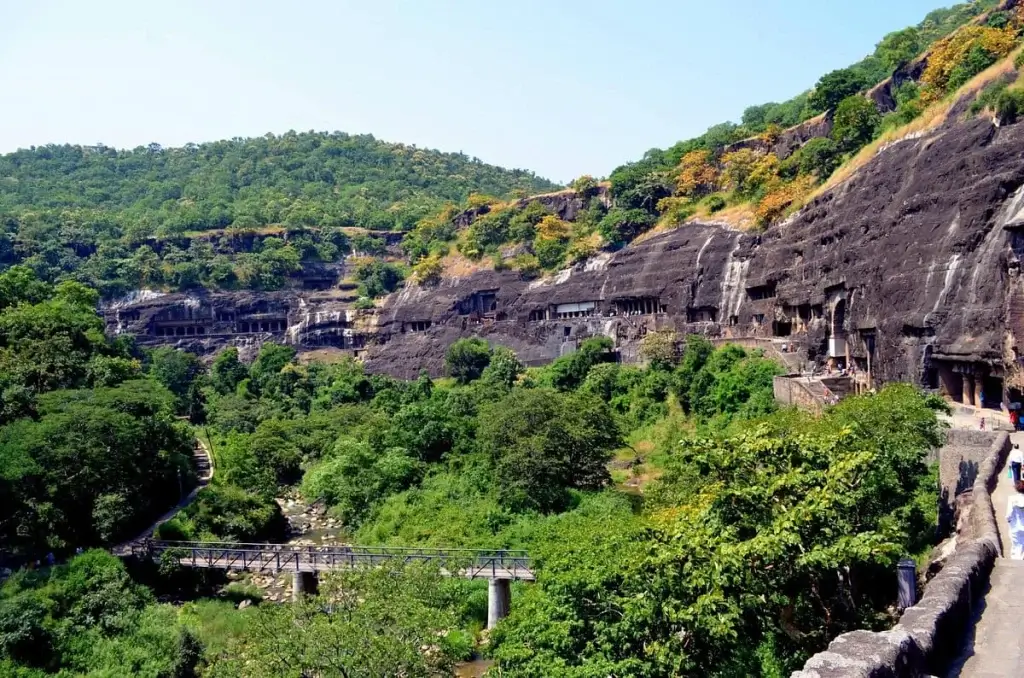
Ajanta Cave is the concoction of 29 different caves, most of which follow similar painting styles. We know that right? So, let us learn more about it.
Many times people ask us to describe the theme of Ajanta painting. So, why not do it today? That too, while describing to you what all is in store for you at the best of Ajanta Caves. Sounds amazing, doesn’t it? So, here it goes!
CAVE 1 AND 2- The Regal Charms Of Ajanta!
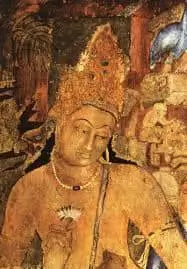
Located at the eastern extremity of the ravine, Cave 1 showcases the most regal charms with a courtyard, verandah, and a seated Buddha. Fit for the ultimate divine power, this cave has been decorated to a craftsman’s full potential.
Star Attractions: Much famed Ajanta cave paintings, Bodhisattva Padmapani and Vajrapani
Cave 2 is no different from Cave 1 until you look above and find the miracle of Shravasti and the dream of Maya delineated so awe-graspingly. Add it now to your travel list, just saying!
CAVE 3 TO 5- Perfect Imperfections!
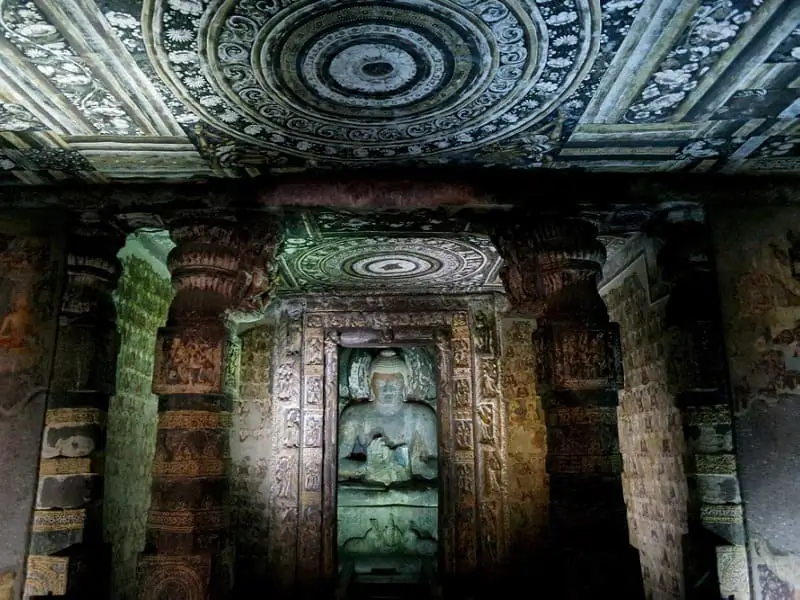
If you wish, you can miss out on caves 3 and 5 as they are just two incomplete caves. But if you will miss Cave 4, oh, it will be a bummer. Why? Well, because it has actual lava marks on its ceilings. Yes, it’s true!
CAVE 6 AJANTA
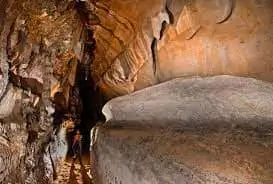
Do you know that cave 6 is the only double-storied cave of Ajanta? No? Well, now you know, along with the information that this cave depicts Buddha in different moods.
The lower floor is no longer available for people to visit. You can visit the upper floor these days where you will find the murals of Buddha teaching his followers the real meaning of Nirvana. Also, paintings of the Shravasti miracle are also put on display here.
CAVE 7 AND 8 – Chill With The Snake King
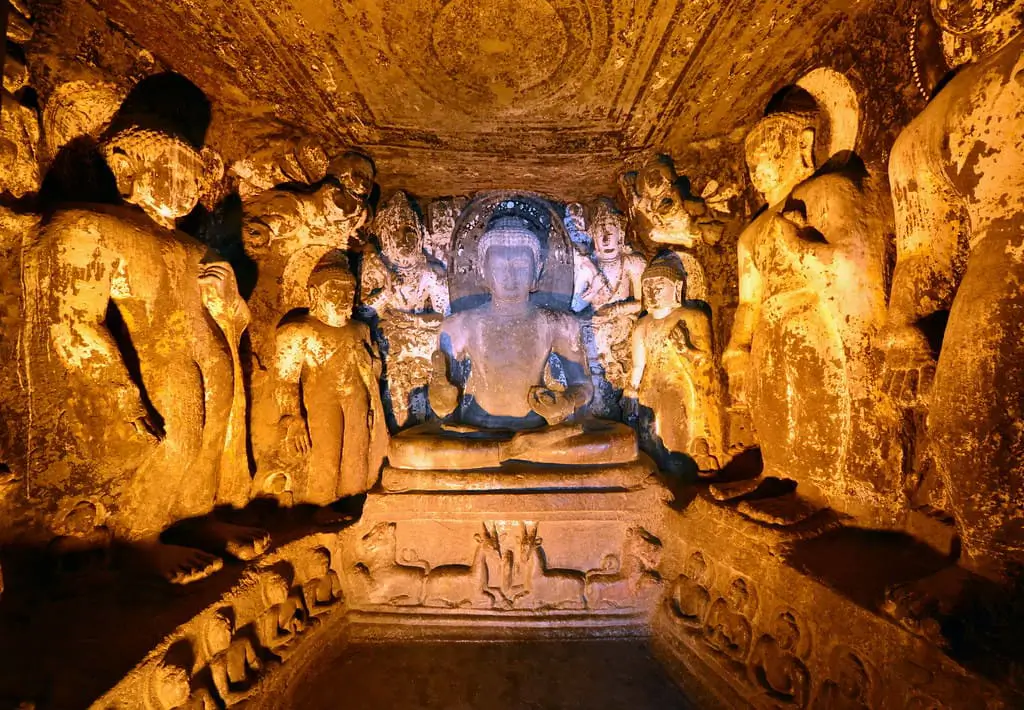
7 cave number is one of the most note-worthy caves of Ajanta. Why do you ask? Well, that’s because it showcases Buddha sheltered by Naga Muchalinda (the many-headed snake king). If this isn’t a sight to behold, we rest our case.
8 number cave is the earliest of the early caves in Ajanta. Now ruined by landslides, it seems incomplete to visitors visiting it for the first time.
CAVE 9 AND 10 – More Buddhist Sagas!
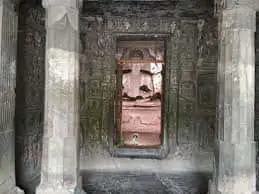
Do you know which prayer hall is the oldest in Ajanta? No!? Then, let us tell you that you are reading about it right now. Yes, Cave 9 is the oldest chaitya excavated in the 1st century BCE. It belongs to the Hinayana sect of Buddhism with 23 pillars separating the aisles.
Paintings in this cave belong to two different eras. So, when you will look keenly, you will notice the difference in their styles as one of them belongs to the time of the first excavation while others belong to the 5th Century CE.
Cave 10 has a similar structure to Cave 9 but has 32 pillars separating the aisle. What makes this cave stand out on our list is its painted representation of Sama Jataka and Chhaddanta Jataka. Intrigued much? Well, we told you the South India tour always comes with surprises.
CAVE 12- Shhh Secrets!
This cave, on the other hand, is a Hinaya Monastery with whimsical paintings over its windows. Although one of its walls has collapsed, it still gives away mystic information about the past. Like, one of the inscriptions records that this monastery was a gift by a merchant named Ghanamadada. Who knows! There can be many more of these easter eggs to look out for.
CAVES 13 TO 15
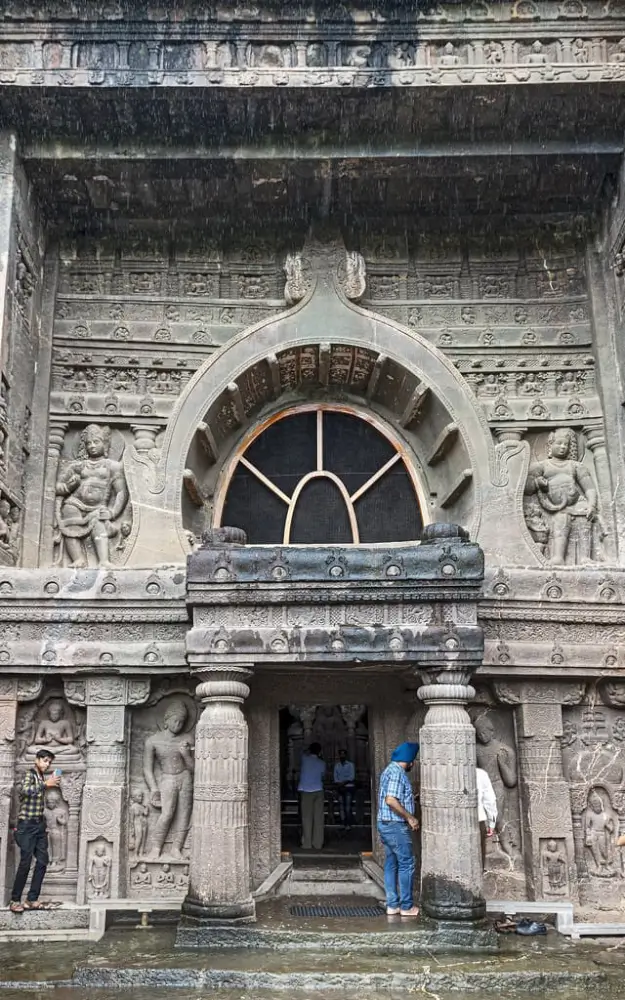
CAVE 15 A AND 16- Tracing The Golden Footprint
13 and 14 are small viharas from the first phase of Ajanta’s construction. Although, there are no notable features to Cave 13, Cave 14 exhibits a stunning depiction of Salabhanjika (a woman breaking a branch of a Shorea tree).
Cave 15 was excavated in the 5th Century CE. Nothing so noteworthy, just a quaint vihara like all the others. So, you can miss it too. wink*
CAVE 15 A AND 16- Tracing The Golden Footprint

Okay, now you must be wondering, why this peculiar naming. Well, that’s because this smallest vihara of Ajanta was buried under the rubble when the caves were being counted. Doesn’t that add oomph to its existence already?
Cave 16 is the largest excavation of all time and the center-most cave of this horse-shoe ravine. In fact, some of the finest murals are stored here, including the statue of Buddha in Pralamba Padasana Mudra. Well, if this got you caught up, then, wait until we tell you that this cave is ornamented with paintings from Buddha’s life. So, get ready to witness various Jataka stories you all!
CAVE 17- Artistic Innovation Redefined
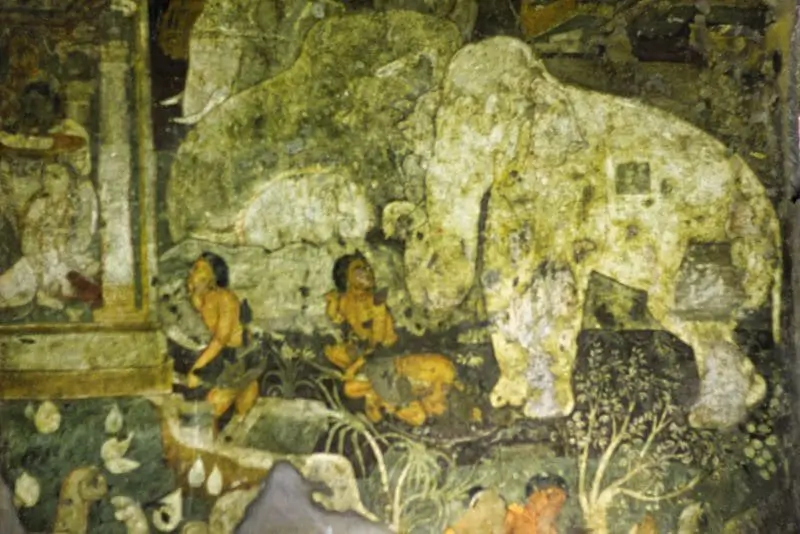
This cave is a Mahayana sect monastery with painted doors, walls, and ceilings. There is a distinct flavor to the art illustrated here. To put it correctly, it is very contemporary and the best example of it is the statue of Buddha sitting with his future self. Isn’t it mind-boggling already!?
CAVE 18 AND 19- Fables And Tales
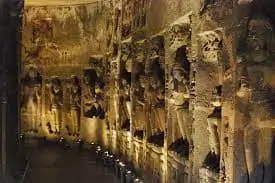
Cave 18 is not a cave, we repeat not a cave. It’s just a counting error. Also, isn’t it hilarious?
Cave 9 is decked in various intricately carved figures and decorative motifs. Most eye-catching of which is Buddha offering his begging bowl to his son Rahul right at the entry door. Furthermore, there is a standing Buddha carved on the front of the Stupa whose umbrella-like crown almost touches the roof. You’ll find Buddha is every possible pose here. And, that is something you should definitely look out for if you have come to Ajanta, don’t you think?
CAVE 26– Final Showdown!
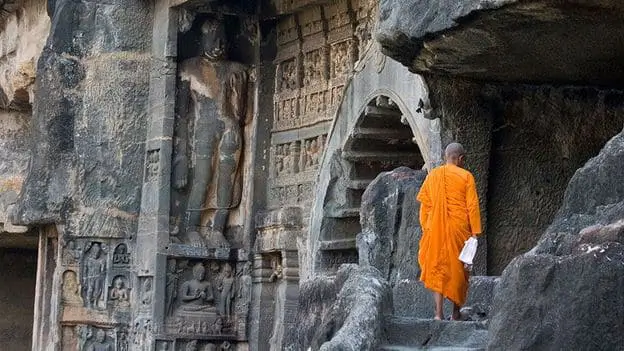
Ajanta caves painting here in cave 26 amazingly illustrate the demise of Buddha and the assault of Mara during Buddha’s penance. Well, it is the perfect climax to the Ajanta trip as it ends with Lord Buddha, don’t you think?
DETAILED INSIGHT ON TOURING AJANTA CAVES
When To Visit Ajanta Caves?
June – March
Ajanta Caves par beauty is a treat for the eye at any time of the year. Still, many a time scorching summer heat aggravates the situation. So, according to us, the best time to visit Ajanta Caves is around June to March.
Out of the months mentioned above, winters (October- March) are Ajanta Ellora caves the best time to visit because of the very pleasant weather.
If you are a fan of monsoon showers that glaze the Indian earth and turns it enchantingly irresistible, then June to September should be ideal for you to visit Ajanta Caves. Disclaimer! Although the trails are well made, it is important for you to know that enjoying the scenic treasures of this place can become a little difficult during this time.
How To Reach Ajanta Caves In India?
Ajanta caves lie within a 100 km radius of Aurangabad. Furthermore, there is a frequent to and fro movement of local transport between Aurangabad and Ajanta. So, finding vehicles is not that big of a task here.
Just get yourself a seat on any local bus and voila after 3.5 hours you’ll be at your destination in just 100-200 bucks. Can’t wait that long? Then, how about booking a cab from Aurangabad that will be minus an hour from your road run? Sounds amazing? Well, then, keep in mind, it will hurt your pockets too.
Local, as well as public transport, will drop you at Ajanta. Still, to get to the caves you will have to take a shuttle bus. Don’t worry; it will only cost about 20-40 bucks and ta-da! You’ve reached Ajanta Caves.
Airport Nearby:
Aurangabad Airport
Railway Station Nearby:
Jalgaon Railway Station
Jalgaon Railway Station
What Are The Ajanta Caves Timings And Days?
Opening days: Every day except Mondays.
Ajanta Caves Timings:
9:00 AM to 5:30 PM
9:00 AM to 5:30 PM
What Are The Charges To Visit Ajanta Caves?
Indian’s Entry fee : INR 40
Foreigner’s Entry fee : INR 600
Camera Fee: INR 25
Entry fee for children under the age of 15: Free
Note: Although You Will Not Have Any Difficulty Spotting The Ticket Counter. You Will Be Surrounded By Guides, Shop-Keepers And Porters. Ignore Them!
You can even pay people to carry you around in chairs here! Can you hear us lazy heads?
Note: Planning a holiday, especially in India can be chaotic, isn’t it? Then, it’s better to plan your cave jaunt in India via a travel agency. Plan this and other South India tours in addition to some Maharashtra adventures to make the most out of your India travel plan. How about giving thegrandindianroute.
a chance? So, why not request a quote?
LAST MINUTE TIPS FOR AJANTA CAVES MAHARASHTRA
1. Plan your stay in Aurangabad. It’s a huge city with dainty charms. So, living here won’t only be feasible but beneficial too.
2. Beware of touts and please don’t buy anything from them. Crystal, pebbles, stones … anything!
3. Wear slip-on shoes. It’s an array of 29 caves, so, you just can’t move everywhere barefooted, right?





